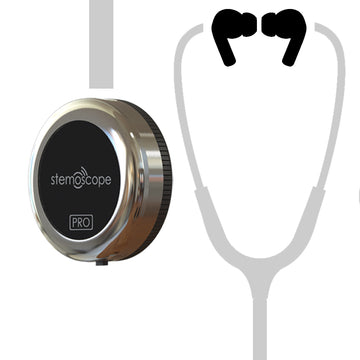Some tips on recording lung sounds with Stemoscope
n case that you want to get the most out of the Stemoscope device and the App, you may consider the following tips when you record lung sounds.
What App settings to use?
Please use the extended range 20-1000 Hz when you do the recording. Though, with this mode, the background/white noise is higher than other modes, it can make sure all the audio components within the 20-1000 Hz range can be captured. Some components of the lung sounds can have a frequency higher than 200 Hz or even 500 Hz.
Where to put the Stemoscope?
The back of the body can be a good place to place the Stemoscope to hear the lung sounds. When a Stemoscope is placed on the front side of the body, the heart sounds are louder, which may introduce some difficulties to differentiate the sound characteristics. To learn the exact location of the back you need to place the Stemoscope, you may ask your doctor. You can take a photo of where the Stemoscope you placed and email it to your doctor to ask for feedback.
How to minimize noise?
To minimize the noise, let’s understand the source of the noise first.
One source of the noise is the background noise, such as people talking and TV speaking. The noise level of a Stemoscope is very close to that of a traditional stethoscope. However, since Stemoscope amplifies the sounds, when it amplifies the signals you want, it also amplifies the background noises. Therefore, when the sounds are all amplified, people may feel the noise is too loud though the characteristics of the signals can still be recognized with our ears. If you lower your phone volume to the level close to a traditional stethoscope, the noise is less audible though the useful sound signal gets weaker, but still in the same level of a traditional stethoscope. The best way to reduce the background noise is to find a quiet place to do the recording. For example, turn off the TV and ask others not to talk when you do the recording.
Another source of the noise is from the friction if you press the Stemoscope on the back of the body with your hands. Our hands are not that stable, and sometimes they vibrate and induce friction noise. To avoid this, it is recommended to use adhesive tape to fix the Stemoscope on the back of the body and you can get clearer sounds.
How to sanitize the Stemoscope?
Please use alcohol wipes to clean all the outer surface. Don’t wash it or dip it in water. You may also keep it personal – one Stemoscope per person.












I am interested in using stemoscope to monitor pre-tracheal sounds in patients under deep sedation. Capnography devices that we routinely use are not infrequently defeated when a patient stops breathing through his/her nose and starts breathing through his/her mouth.